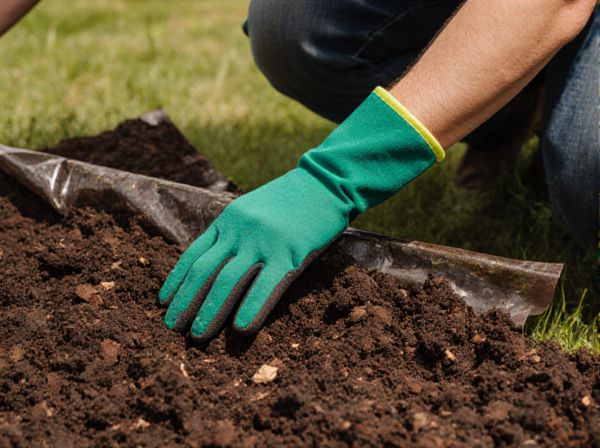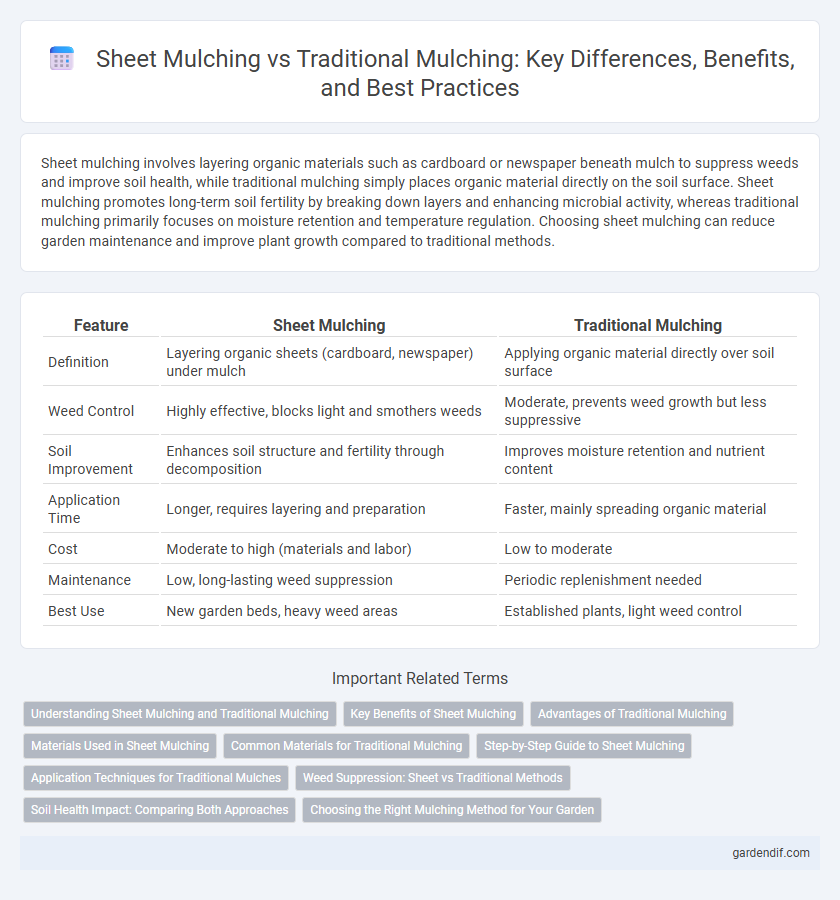
Sheet Mulching vs Traditional Mulching Illustration
Sheet mulching involves layering organic materials such as cardboard or newspaper beneath mulch to suppress weeds and improve soil health, while traditional mulching simply places organic material directly on the soil surface. Sheet mulching promotes long-term soil fertility by breaking down layers and enhancing microbial activity, whereas traditional mulching primarily focuses on moisture retention and temperature regulation. Choosing sheet mulching can reduce garden maintenance and improve plant growth compared to traditional methods.
Table of Comparison
| Feature | Sheet Mulching | Traditional Mulching |
|---|---|---|
| Definition | Layering organic sheets (cardboard, newspaper) under mulch | Applying organic material directly over soil surface |
| Weed Control | Highly effective, blocks light and smothers weeds | Moderate, prevents weed growth but less suppressive |
| Soil Improvement | Enhances soil structure and fertility through decomposition | Improves moisture retention and nutrient content |
| Application Time | Longer, requires layering and preparation | Faster, mainly spreading organic material |
| Cost | Moderate to high (materials and labor) | Low to moderate |
| Maintenance | Low, long-lasting weed suppression | Periodic replenishment needed |
| Best Use | New garden beds, heavy weed areas | Established plants, light weed control |
Understanding Sheet Mulching and Traditional Mulching
Sheet mulching involves layering cardboard or newspaper beneath organic matter to suppress weeds, improve soil health, and retain moisture, effectively mimicking natural forest floor processes. Traditional mulching typically uses loose materials like wood chips or straw spread directly on the soil surface to moderate temperature and reduce erosion. Both methods enhance soil fertility over time, but sheet mulching offers a more comprehensive approach to weed control and soil amendment.
Key Benefits of Sheet Mulching
Sheet mulching improves soil health by enhancing moisture retention, reducing weed growth, and promoting beneficial microbial activity. Unlike traditional mulching, it creates a natural composting layer that enriches soil nutrients over time. This method also minimizes labor and reduces the need for chemical fertilizers, making it an eco-friendly gardening practice.
Advantages of Traditional Mulching
Traditional mulching offers superior soil moisture retention and temperature regulation by creating a consistent protective layer that reduces evaporation. It enhances organic matter content as natural mulch materials decompose, improving soil structure and fertility over time. This method also suppresses weed growth effectively while providing an immediate aesthetic appeal and habitat for beneficial soil organisms.
Materials Used in Sheet Mulching
Sheet mulching utilizes layers of organic materials such as cardboard, newspaper, compost, and straw to suppress weeds and improve soil fertility, creating a nutrient-rich environment for plants. Traditional mulching generally employs wood chips, bark, or shredded leaves primarily for moisture retention and temperature regulation. The strategic layering in sheet mulching enhances soil structure and microbial activity more effectively than the single-layer application in traditional mulching methods.
Common Materials for Traditional Mulching
Common materials for traditional mulching include wood chips, straw, shredded leaves, grass clippings, and bark mulch, each providing distinct benefits such as moisture retention, weed suppression, and soil temperature regulation. Wood chips decompose slowly, enriching soil over time, while straw and shredded leaves break down faster, contributing quicker nutrient release. Grass clippings offer a nitrogen-rich option but must be applied thinly to avoid matting and odor issues, making material choice critical for effective mulching outcomes.
Step-by-Step Guide to Sheet Mulching
Sheet mulching involves layering organic materials directly onto the soil, starting with a base of cardboard or newspaper to suppress weeds, followed by compost and mulch to enrich soil fertility and retain moisture. This method promotes soil health by improving structure and microbial activity, contrasting traditional mulching which typically only applies a single layer of mulch on top of the soil. For effective sheet mulching, ensure each layer is sufficiently moist and overlap cardboard sheets to prevent weed growth, finishing with a 3-4 inch thick mulch layer to protect and nourish the soil.
Application Techniques for Traditional Mulches
Traditional mulching involves spreading organic materials such as wood chips, straw, or bark evenly around plants, maintaining a 2-4 inch depth to suppress weeds and retain soil moisture. Application techniques emphasize avoiding mulch contact with plant stems to prevent rot and pests, and refreshing mulch layers annually to sustain soil health and temperature regulation. Proper application enhances soil aeration and encourages beneficial microbial activity, promoting optimal plant growth and resilience.
Weed Suppression: Sheet vs Traditional Methods
Sheet mulching offers superior weed suppression by creating a dense barrier that blocks sunlight and inhibits weed growth, unlike traditional mulching which may leave gaps allowing weeds to emerge. Traditional mulch, such as bark or straw, primarily suppresses weeds by shading but can be less effective in preventing deep-rooted or persistent weed species. The thick layers of cardboard or newspaper in sheet mulching not only smother weeds but also improve soil health, enhancing long-term weed control compared to traditional methods.
Soil Health Impact: Comparing Both Approaches
Sheet mulching enhances soil health by improving moisture retention, reducing erosion, and fostering beneficial microbial activity through layered organic materials. Traditional mulching, while effective at conserving soil moisture and suppressing weeds, often decomposes faster and provides fewer long-term soil enrichment benefits. Comparing both, sheet mulching offers a more sustainable strategy for building soil structure and nutrient availability over time.
Choosing the Right Mulching Method for Your Garden
Sheet mulching enhances soil structure and suppresses weeds by layering organic materials directly on planting beds, making it ideal for new garden areas or soil improvement projects. Traditional mulching, using bark, straw, or wood chips, excels at moisture retention and temperature regulation around established plants and garden beds. Selecting the right method depends on garden goals, soil condition, and plant type to maximize growth and sustainability.
Sheet Mulching vs Traditional Mulching Infographic

 gardendif.com
gardendif.com